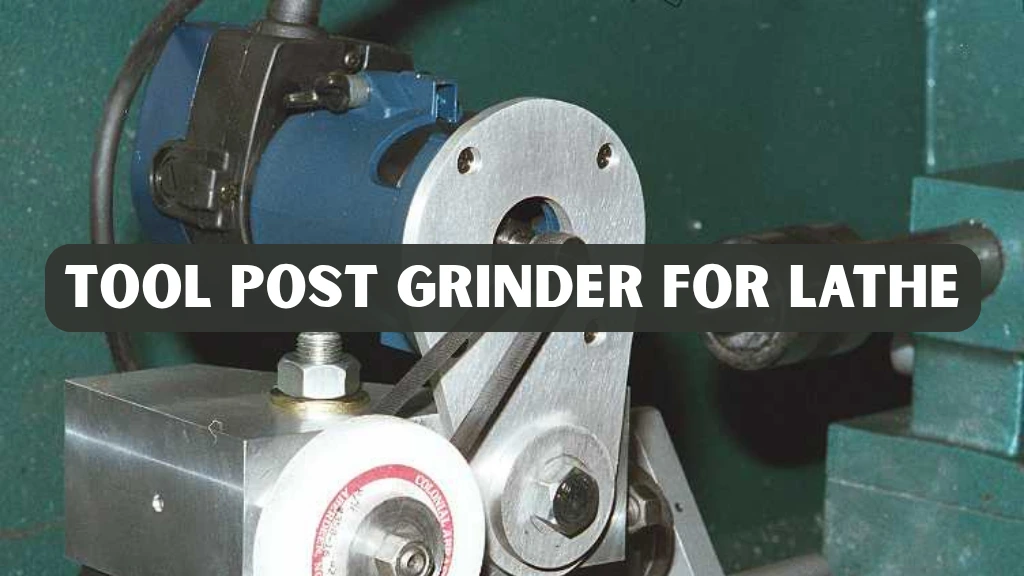A tool post grinder for lathe is a powerful attachment that greatly expands the versatility of a standard lathe machine. While lathes are primarily designed for cutting and shaping with traditional tools, a grinder makes it possible to achieve surface finishes, tolerances, and hardened material work that turning tools alone cannot accomplish. This accessory transforms the lathe into a multipurpose machine, capable of handling grinding tasks usually reserved for specialized equipment.
For machinists, the ability to perform both turning and grinding on the same machine saves valuable time, money, and space in the workshop. From cylindrical grinding to finishing hardened steel shafts, a tool post grinder is an investment in accuracy and performance. In this guide, we will examine the workings of this tool, its advantages and challenges, real-world applications, maintenance strategies, expert advice, and a case study that illustrates its importance in professional machining.
What is a Tool Post Grinder for Lathe?
At its core, a tool post grinder is a compact grinding attachment mounted on the tool post of a lathe. Instead of a cutting tool, it uses a high-speed rotating abrasive wheel to remove material. The wheel grinds the workpiece surface with precision, producing finishes that are smooth, consistent, and within very tight tolerances.
This accessory is particularly valuable when working with hardened materials that cannot be machined with standard tools. It also comes into play when a workpiece demands extreme accuracy in roundness or diameter. By allowing a lathe to function as both a turning and grinding machine, the grinder bridges a crucial gap in the workshop.
How a Tool Post Grinder Works
The working principle of a tool post grinder is straightforward but requires careful execution. The grinder is mounted securely on the lathe’s tool post, where a normal cutting tool would be positioned. Once the grinder is powered, the motor drives the abrasive wheel at high speed. The machinist then uses the lathe’s carriage and cross-slide to feed the wheel against the workpiece.
Since grinding removes very small amounts of material per pass, the process is slow but extremely precise. By taking light passes and measuring often, machinists can achieve tolerances within a few thousandths of an inch. Proper alignment is critical because even small misadjustments can cause uneven grinding, chatter, or damage to the workpiece. Patience and skill are therefore just as important as the machine itself.
Components of a Tool Post Grinder
A typical grinder is made up of several interconnected parts that each serve an essential role. At the heart of the device is the electric motor, which provides the rotational power necessary to drive the grinding wheel. The motor is typically between 0.25 and 1 horsepower, which is sufficient for most grinding applications on a lathe.
Attached to the motor is the spindle assembly, which holds the grinding wheel in place. The wheel itself comes in various types, including aluminum oxide and silicon carbide, chosen depending on the material being machined. To secure the unit to the lathe, a mounting bracket ensures stability and alignment during operation. Guards and covers shield the operator from flying sparks and debris, while the drive system, which may be belt-driven or direct-drive, transfers power smoothly to the wheel.
Each component must be in good working order to ensure accuracy and safety. Together, they allow the tool post grinder to function as a precise extension of the lathe.
Advantages of Using a Tool Post Grinder
One of the biggest advantages of a tool post grinder is its ability to handle hardened materials. Traditional turning tools cannot cut hardened steel effectively, but a grinder can polish, shape, and refine such metals with ease. This makes it indispensable in repair work and precision finishing.
The grinder also offers exceptional accuracy. Skilled machinists can achieve tolerances as tight as half a thousandth of an inch, which is especially important in applications like shaft repair or die work. Another advantage is the improved surface finish. Grinding can produce mirror-like finishes that are not achievable with ordinary turning.
From a practical standpoint, the attachment also saves space. Instead of investing in a separate cylindrical grinder, workshops can use their existing lathe for both turning and grinding. This cost-saving benefit is particularly appealing for smaller operations and hobbyists.
Limitations and Challenges
Despite its many benefits, the tool post grinder does come with limitations. One of the most significant issues is the abrasive dust produced during grinding. If not managed properly, this dust can settle on the lathe’s precision ways and cause wear over time. Machinists must therefore use protective covers and clean the machine thoroughly after each grinding session.
Setup is another challenge. Achieving the correct alignment between the grinding wheel and the workpiece requires time and skill. Inaccuracies during setup can lead to poor surface quality or even damage to the part. Additionally, tool post grinders are generally noisier and less powerful than dedicated surface or cylindrical grinders. For high-volume industrial grinding, a specialized machine is still the better choice.
Tool Post Grinder in Modern Workshops
In today’s workshops, efficiency and precision are critical. The use of a tool post grinder for lathe operations gives machinists the ability to complete grinding work without outsourcing tasks to specialized shops. This not only reduces costs but also shortens turnaround times.
Small manufacturers often use grinders to restore worn shafts or finish bores in bushings. Repair shops rely on them to salvage parts that would otherwise be scrapped. Hobbyists value them as a way to explore advanced machining techniques and to work with hardened materials. In every case, the grinder represents flexibility, enabling one machine to perform multiple roles.
Commercial vs DIY Tool Post Grinders
Commercial grinders from manufacturers such as Dumore and Themac are widely respected for their precision and durability. These models are designed for long-term use, with high-quality bearings, balanced spindles, and carefully engineered housings. They are the preferred choice for professional machinists who demand reliability.
On the other hand, many machinists experiment with building their own grinders. A common approach is to adapt a small motor or a palm router to function as a grinding spindle. While a DIY tool post grinder for lathe may lack the refinement of commercial models, it can still be effective for light-duty tasks. For hobbyists, this offers a cost-efficient way to expand their capabilities while learning valuable skills.
Real-World Applications
Tool post grinders are valued for their wide range of applications in machining. One of their most common uses is cylindrical grinding, where shafts and round components are finished to exact dimensions and smooth surfaces. Internal grinding is also a frequent task, achieved with smaller abrasive wheels that refine bores with exceptional accuracy. These operations make the grinder an essential tool when precision beyond normal turning is required.
Beyond shaping parts, tool post grinders play a crucial role in tool and die work, where they create exact fits and restore surfaces. They are also highly effective for sharpening cutting tools, which extends their life and reduces operating costs. In repair and restoration, they can grind worn or hardened components back into proper condition, saving the expense of replacements. These practical applications emphasize the grinder’s role as a reliable problem-solving tool in any workshop.
Maintenance and Safety
Like all workshop equipment, a grinder requires regular maintenance to perform at its best. Grinding wheels must be dressed frequently to maintain their shape and sharpness. Motors and belts should be checked for wear, and bearings need occasional inspection. Cleanliness is crucial; abrasive dust should never be allowed to accumulate on the lathe.
Safety cannot be overlooked. Operators should always wear eye protection, dust masks, and hearing protection. Grinding wheels should be selected carefully, ensuring they are rated for the machine’s operating speed. Over-speeding a wheel can lead to catastrophic failure. Finally, only light passes should be taken during grinding, as forcing the wheel can result in chatter or heat damage to the workpiece.
Case Study Precision Shaft Restoration
John Mitchell, a professional machinist with more than 15 years of experience, recently worked on restoring a hardened steel shaft that could not be cut with conventional tools. To solve the challenge, he mounted a tool post grinder for lathe operations and carefully aligned it for accuracy. Using a fine-grit wheel, he removed material in light passes and checked the shaft’s dimensions frequently with micrometers to maintain precision. His patience and methodical approach allowed him to achieve the required tolerances while maintaining full control of the process.
After several finishing passes, the shaft was restored to perfect roundness and a smooth surface finish that met all technical requirements. The client reported that machine performance improved significantly, eliminating the need for an expensive replacement part. This real-world case shows how a tool post grinder can solve machining problems that turning alone cannot achieve. It also demonstrates the importance of precision, consistency, and expert technique when handling hardened materials in demanding restoration projects.
Expert Tips for Successful Grinding
Experienced machinists recommend covering the lathe’s precision ways with protective material to shield them from abrasive dust. Using multiple wheels of different grits also helps in achieving both roughing and finishing goals. Dressing the wheel regularly ensures consistent cutting performance, while keeping passes light avoids vibration and overheating.
Proper alignment is critical, and machinists often spend extra time adjusting the setup before starting any grinding operation. Patience, precision, and attention to detail are the keys to consistent results.
Conclusion
A tool post grinder for lathe is more than just an accessory; it is a gateway to precision and versatility in machining. By enabling grinding on a standard lathe, it allows machinists to work with hardened materials, achieve high tolerances, and produce mirror-like finishes. While it demands careful setup, maintenance, and dust protection, the benefits it brings to a workshop are undeniable.
From commercial shops to hobbyist garages, this attachment proves its worth by saving costs, enhancing efficiency, and expanding the range of work that a lathe can accomplish. Whether purchased from a manufacturer or built as a DIY project, the tool post grinder remains an indispensable solution for modern machinists.
FAQs
Can any lathe use a tool post grinder?
Most medium and heavy-duty lathes can handle grinders effectively. Smaller benchtop lathes may face issues with vibration.
What type of grinding wheel should I choose?
Aluminum oxide wheels are best for steel, while silicon carbide is more suitable for carbide and non-ferrous metals.
Is it better to buy a grinder or build one?
Commercial grinders offer superior accuracy and durability, but DIY options are practical for light use and experimentation.
How do I protect my lathe from abrasive dust?
Use plastic covers, shields, or protective cloths to prevent dust from settling on the way. Always clean thoroughly after grinding.
Can grinding improve the life of machine tools?
Yes, by sharpening and refining edges, grinding can extend the lifespan of tools and restore worn machine parts.




